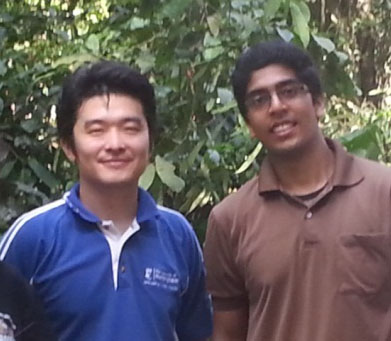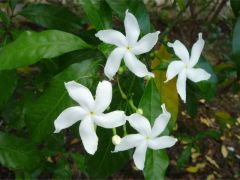March 7, 2016, by Editor
Championing collaboration; The Jerantinine story … so far …
In recognition of International Women`s Day, this blog has been written by Dr. Tracey D Bradshaw, assistant professor in The School of Pharmacy, University of Nottingham.
I have been affiliated with The School of Pharmacy, University of Nottingham for 25 years, arriving in 1991 as a post doc working briefly for Dr. Martin Garnett and then for 6 months for Prof Baldwin. In January 1993, I joined Professor Malcolm Stevens` group as the `biology` arm of his experimental cancer chemotherapy and drug discovery group in the old Cancer Research Laboratories. Since then, I have been involved in many inspirational projects involving design, development, identification and mechanistic elucidation of novel experimental agents to treat intractable cancers. Such research led to clinical evaluation of Phortress.
In this blog, I would like to share with you exciting multidisciplinary research undertaken by cross-campus University of Nottingham, University of Warwick, Swiss, International Medical University colleagues – a global collaboration.
Up front, I acknowledge the remarkable talents and generous enthusiasm of Dr. Kuan-Hon Lim (University of Nottingham in Malaysia Campus (UNMC)), Prof Toh-Seok Kam (University of Malaya), Dr. Vijay Raja, Mr. Mohannad Qazzaz, assoc. Prof. John Moses, Mr. Paul Stanley, Dr. Beth Coyle, Dr. Claire Seedhouse, Dr. Hilary Collins, Dr. Pavel Gershkovich (University of Nottingham), Prof. Anne Straube (University of Warwick), Prof. Michel Steinmetz (Paul Scherrer Institut) and Prof Chee-Onn Leong (International Medical University).
Jerantinines
Jerantinines A-E are five novel indole alkaloids isolated (by Dr. Kuan-Hon Lim) from Tabernaemontana corymbosa in the beautiful Malaysian rainforest – a breath-taking back-drop to UNMC.
Vijay Raja during his PhD demonstrated powerful antitumour activity of Jerantinine A, identifying a mechanism of action which included tubulin polymerisation inhibition. Mohannad Qazzaz subsequently revealed enhanced potency of Jerantinine B against human-derived breast, colorectal, pancreatic, lung carcinoma cell lines. Moreover, these plucky alkaloids evaded the insidious multi-drug resistance (MDR) acquired following cancer chemotherapy treatment which devastatingly leads to treatment failure and patient relapse. Heart-breakingly common in paediatric medulloblastoma (MB), expression of the MDR protein P-glycoprotein (P-gp) renders chemotherapy ineffective and patients and their families helpless. Dr. Beth Coyle irrefutably showed that (unlike Vincristine, used in treatment of this disease) Jerantinines A and B are active in models of P-gp positive MB. Through collaboration with Professor Anne Straube at Warwick, Mohannad was able to demonstrate potent inhibition of microtubule dynamicity – i.e. seeded tubulin was unable to form the microtubules necessary for chromosome segregation and separation imperative during the mitotic phase of cell division. Professor Michel Steinmetz and his team subsequently resolved the crystal structure of Jerantinine B acetate bound to the colchicine binding site of tubulin.
Trained by Emeritus Professor Malcolm Stevens OBE, FRS, I recognise that all molecules possess a `rich and diverse pharmacology` – perhaps especially true for Nature`s pharmaceutical treasures which have evolved structural diversity and precision over billions of years to protect their host organism. Further mechanistic excavation uncovered dose-dependent, significant inhibition of polo-like kinase 1 (PLK-1), an oncogenic mitotic kinase. Professor Chee-Onn Leong, director of Cancer Studies at IMU (and incidentally Nottingham University School of Pharmacy alumnus), through multidimensional proteomic techniques identified spliceosome proteins targeted by Jerantinine A. Faulty gene splicing in cancer results in expression of splice variant proteins (e.g. anti-apoptotic, pro-survival proteins), contributing to cancer pathogenesis. Spliceosome protein defects are evident in a number of leukaemia sub-types – potential targets for therapeutic intervention? Dr. Claire Seedhouse is to investigate.
Of course, Nature excels in building molecular structural diversity, evolving wily enzymatic nuances to produce exquisitely active compounds – elusive to many scientists – not so however if you are natural product chemists Professor John Moses and Paul Stanley, whose acuity has led to (as this piece is being written) synthesis of Jerantinine analogues –which will allow thorough interrogation of structure-activity-relationships (SAR) in the hope that one day new drug candidates will be produced to treat intractable cancers.




Wonderful work Tracey and you are truly an inspirational role model to womankind. Happy international women’s day!